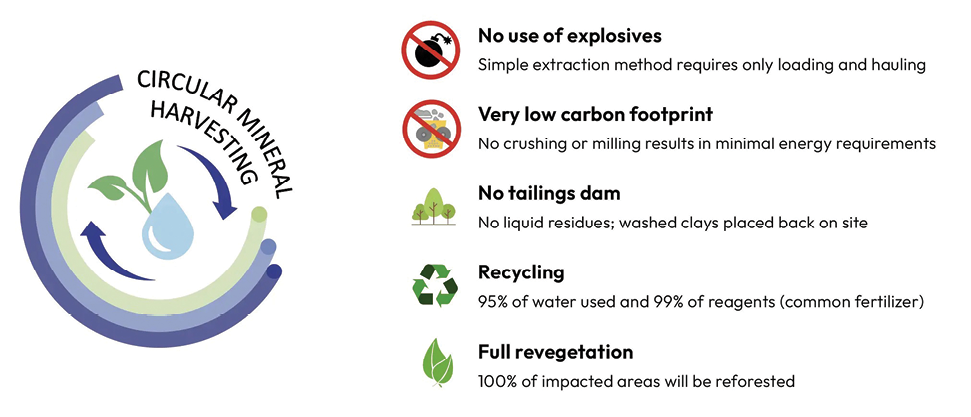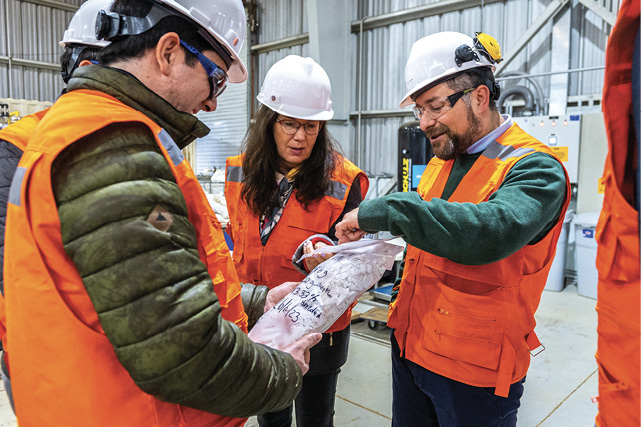Circular mineral harvesting
The future of clean mining and environmental sustainability

As the world moves toward a sustainable energy future, the demand for rare earth elements (REEs) is rapidly increasing. These elements are essential for the production of clean technologies, such as electric vehicles (EVs) and wind turbines. Traditional methods of extracting these valuable resources can pose environmental challenges. Aclara Resources is redefining mining practices with its innovative clean extraction technology: Circular mineral harvesting. This approach not only aligns with global sustainability goals but also sets a new standard for environmentally responsible mining.
The need of clean mining in the modern world
Mining has long been a cornerstone of industrial development, providing the raw materials necessary for technological advancement. As the global community becomes more aware of the environmental impact of industrial activities, the demand for cleaner, more sustainable mining practices has never been greater. This is especially true in the REEs sector, where the materials are essential for developing green technologies but are traditionally associated with environmentally intensive extraction processes.
Recognizing the need to innovate in both production and extraction methods, Aclara Resources developed “circular mineral harvesting,” a patented process designed to minimize environmental impact while maximizing efficiency.
Circular mineral harvesting: A new approach to rare earth extraction
Circular mineral harvesting represents an innovative approach to mining. Traditional mining methods typically involve processes, such as blasting, crushing, and milling, which can have significant environmental footprints. In contrast, this innovative process eliminates the need for these activities, thereby reducing the energy required for extraction and maximizing harmony to the surrounding environment.
One of the most notable features of this technology is that it does not produce liquid residues, ensuring more efficient waste management and enhancing environmental safety compared to traditional mining operations. Instead, the process recycles approximately 95% of the water used and 99% of the main reagent, a common fertilizer, ensuring that operations are both resource-efficient and environmentally friendly.
The commitment to sustainability extends beyond the extraction process, with full reforestation of all areas impacted by mineral extraction, ensuring that local ecosystems are preserved and restored.
Aligning with global sustainability goals
The global move towards sustainability is not just a trend; it signifies a fundamental shift in how industries operate. Governments, investors, and consumers are increasingly prioritizing environmental stewardship, and companies that fail to adapt may be left behind. Aclara’s clean extraction technology is aligned with key international initiatives. This year, the company joined the United Nation’s Global Compact Network in Chile, a commitment to both sustainability and transparency, requiring annual reporting on progress towards these goals. This alignment not only enhances project appeal to investors but also ensures readiness for increasingly stringent regulatory environments.
The economic and environmental benefits of circular mineral harvesting
The benefits of circular mineral harvesting extend beyond environmental sustainability, translating into significant economic advantages. By reducing the energy required for extraction and minimizing waste, operational costs are lowered, making projects more economically viable. This allows for competitive product pricing while maintaining high standards of environmental responsibility.
The technology minimizes the need for traditional mining infrastructure, such as tailings dams, leading to lower capital expenditure for new projects and simplifying the management of waste material. The focus then shifts to further advancing technology and expanding operations.
Transparency and community engagement
Transparency and community engagement are essential components of sustainable development. Maintaining open communication with all stakeholders, including local communities, government agencies, and investors, ensures that needs are addressed and that operations align with the broader goals of the communities involved.

displays heavy rare earth carbonates to a Brazilian delegation at the Aclara
pilot plant earlier this year. CREDIT: ACLARA RESOURCES
Regular environmental and social impact assessments are conducted to identify potential challenges and opportunities. This approach enables informed decisions that benefit both the business and the environment. Close collaboration with local communities fosters reforestation and land reclamation programs, contributing to the long-term health and vitality of the ecosystems involved.
Beyond environmental initiatives, supporting the economic development of the regions where operations are based is crucial. By creating jobs, providing training, and investing in local infrastructure, resilient communities are built, thriving long after the mining operations have ended.
The future of clean mining
As the future unfolds, the commitment to clean mining and environmental stewardship remains a priority. The demand for REEs will only increase as the world transitions to a more sustainable energy future and meeting this demand in an economically viable and environmentally responsible manner is crucial.
Circular mineral harvesting technology is just the beginning, with ongoing research and development focused on improving processes, reducing environmental impact, and contributing to the global effort to address climate change. By embracing innovation and sustainability, a brighter, more sustainable future is within reach.
The proprietary circular mineral harvesting technology represents a new era in mineral extraction, prioritizing sustainability, efficiency, and community engagement, ensuring that the resources needed to power the future are extracted in a way that respects the environment and benefits society.
Ramon Barua Costa is CEO, Aclara Resources.
Comments